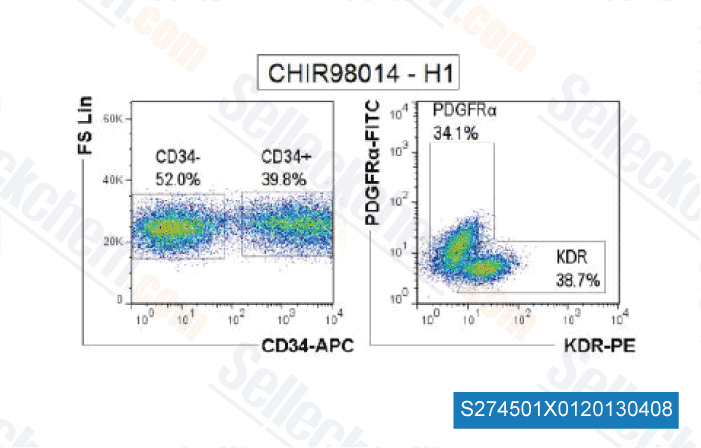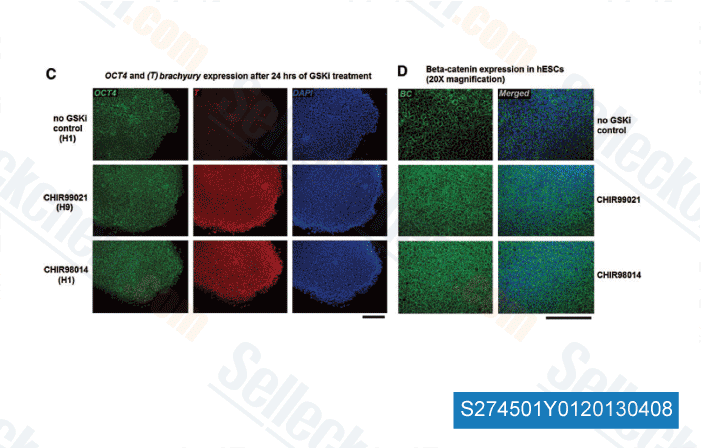|
Toll Free: (877) 796-6397 -- USA and Canada only -- |
Fax: +1-832-582-8590 Orders: +1-832-582-8158 |
Tech Support: +1-832-582-8158 Ext:3 Please provide your Order Number in the email. |
Technical Data
| Formula | C20H17Cl2N9O2 |
|||
| Molecular Weight | 486.31 | CAS No. | 252935-94-7 | |
| Solubility (25°C)* | In vitro | DMSO | 8 mg/mL (16.45 mM) | |
| Water | Insoluble | |||
| Ethanol | Insoluble | |||
|
* <1 mg/ml means slightly soluble or insoluble. * Please note that Selleck tests the solubility of all compounds in-house, and the actual solubility may differ slightly from published values. This is normal and is due to slight batch-to-batch variations. * Room temperature shipping (Stability testing shows this product can be shipped without any cooling measures.) |
||||
Preparing Stock Solutions
Biological Activity
| Description | CHIR-98014 (CT98014) is a potent GSK-3α/β inhibitor with IC50 of 0.65 nM/0.58 nM in cell-free assays, with the ability to distinguish GSK-3 from its closest homologs Cdc2 and ERK2. | ||||
|---|---|---|---|---|---|
| Targets |
|
||||
| In vitro | CHIR-98014 inhibits human GSK-3β with Ki of 0.87 nM. CHIR-98014 is very effective in preventing murine and rat GSK-3. Although CHIR-98014 acts as a simple competitive inhibitor of ATP binding, it displays from 500-fold to >1000-fold selectivity for GSK-3 versus 20 other protein kinases including Cdc2, ERK2, Tie-2 and KDR. CHIR-98014 prevents Cdc2 with IC50 of 3.7 μM. However, CHIR 98014 reveals similar ptoency against the highly homologous ɑ and β isoforms of GSK-3, it is noteworthy that it stronly discriminated between GSK-3 and its closest homologs CDC2 and ERK2. Exposure of insulin receptor-expressing CHO-IR cells or primary rat hepatocytes to increasing concentrations of inhibitor CHIR98014 results in a two- to three-fold stimulation of the GS activity ratio above basal. The concentrations of CHIR-98014 giving rise to half-maximal GS stimulation (EC50) is 106 nM and 107 nM for CHO-IR and rat hepatocytes, respectively. [1] | ||||
| In vivo | GSK-3 inhibitor CHIR-98014 activates the GS activity ratio in isolated type I skeletal muscle from insulin-sensitive lean Zucker and from insulin-ressitant ZDF rats. Soleus muscle isolated from ZDF rats shows significant resistance to insulin for activation of GS but responded to 500 nM CHIR-98014 to the same extent (40% increase) as muscle from lean Zucker rats. Notably, GS activation by insulin plus CHIR-98014 is additive in muscle from lean Zucker rats and greater than additive in muscle from the ZDF rats. Total GS activity is not altered by either CHIR-98014 or insulin in these cells and muscles. Meanwhile, CHIR-98014 does not influence the insulin dose-response in muscle from lean animals. The reduction in hyperglycemia and improved glucose disposal are not limited to db/db mice and ZDF rats, as similar results are observed with ob/ob mice, diet-induced diabetic C57BL/6 mice, and glucose-intolerant SHHF rats treated with CHIR-98014. [1] Additionally, CHIR-98014 decreases the phosphorylation (Ser396) of tau protein in the cortex and hippocampus of postnatal rats. [2] |
Protocol (from reference)
| Kinase Assay: |
|
|---|---|
| Cell Assay: |
|
| Animal Study: |
|
References
|
Customer Product Validation

-
Data from [Stem Cells Dev, 2013, 22, 1893-90]

-
Data from [Stem Cells Dev, 2013, 22, 1893-90]

-
Data from [Stem Cells Dev, 2013, 22, 1893-90]

-
, , Cancer Res, 2013, 73(4):1340-51.
Selleck's CHIR-98014 has been cited by 59 publications
| Nociceptor-immune interactomes reveal insult-specific immune signatures of pain [ Nat Immunol, 2024, 25(7):1296-1305] | PubMed: 38806708 |
| RNA m6A modification regulates L1 retrotransposons in human spermatogonial stem cell differentiation in vitro and in vivo [ Cell Mol Life Sci, 2024, 81(1):92] | PubMed: 38363375 |
| Identification of novel neuroprotectants against vincristine-induced neurotoxicity in iPSC-derived neurons [ Cell Mol Life Sci, 2024, 81(1):315] | PubMed: 39066803 |
| PIM1 drives lipid droplet accumulation to promote proliferation and survival in prostate cancer [ Oncogene, 2024, 43(6):406-419] | PubMed: 38097734 |
| Enhancing Maturation and Translatability of Human Pluripotent Stem Cell-Derived Cardiomyocytes through a Novel Medium Containing Acetyl-CoA Carboxylase 2 Inhibitor [ Cells, 2024, 13(16)1339] | PubMed: 39195229 |
| Inhibition of DNMT3B expression in activated hepatic stellate cells overcomes chemoresistance in the tumor microenvironment of hepatocellular carcinoma [ Sci Rep, 2024, 14(1):115] | PubMed: 38168140 |
| Characterization of the BH1406 non-small cell lung cancer (NSCLC) cell line carrying an activating SOS1 mutation [ Transl Lung Cancer Res, 2024, 13(11):2987-2997] | PubMed: 39670010 |
| Lgr6-expressing functional nail stem-like cells differentiated from human-induced pluripotent stem cells [ PLoS One, 2024, 19(5):e0303260] | PubMed: 38743670 |
| Lgr6-expressing functional nail stem-like cells differentiated from human-induced pluripotent stem cells [ PLoS One, 2024, 19(5):e0303260] | PubMed: 38743670 |
| Development of a live cell assay for real-time monitoring the interactions between the Hippo pathway components 14-3-3 and TAZ [ SLAS Discov, 2024, 29(8):100191] | PubMed: 39510350 |
RETURN POLICY
Selleck Chemical’s Unconditional Return Policy ensures a smooth online shopping experience for our customers. If you are in any way unsatisfied with your purchase, you may return any item(s) within 7 days of receiving it. In the event of product quality issues, either protocol related or product related problems, you may return any item(s) within 365 days from the original purchase date. Please follow the instructions below when returning products.
SHIPPING AND STORAGE
Selleck products are transported at room temperature. If you receive the product at room temperature, please rest assured, the Selleck Quality Inspection Department has conducted experiments to verify that the normal temperature placement of one month will not affect the biological activity of powder products. After collecting, please store the product according to the requirements described in the datasheet. Most Selleck products are stable under the recommended conditions.
NOT FOR HUMAN, VETERINARY DIAGNOSTIC OR THERAPEUTIC USE.
